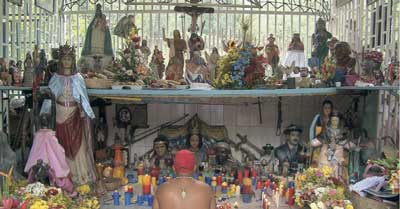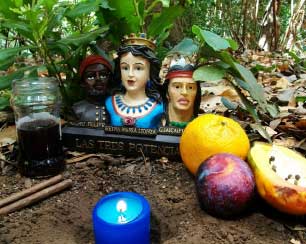 The Venezuelan deity Maria Lionza concentrates varied meanings of femininity thanks to her original and variable transformations. In her original image is a spirit or cosmic force, telluric, symbol of fertility of the earth, and by the analogy of the mother woman.
The Venezuelan deity Maria Lionza concentrates varied meanings of femininity thanks to her original and variable transformations. In her original image is a spirit or cosmic force, telluric, symbol of fertility of the earth, and by the analogy of the mother woman.
As a giver deity of rain, rivers, lakes, hills, mountains, she is patron of wild animals, especially game animal (tapir, deer, snow leopard or jaguar), whose representation assumes, like that of the great tiller of the waters: the anaconda. She represents the virgin nature personified in a nude young woman of seductive beauty.
This ancient symbolism of Maria Lionza resembles her to the few female deities of the extinct indigenous peoples and other survivors. In northwestern Venezuela, the region in which her origin is located, there are abundant archaeological pieces of pre-Columbian indigenous enabling this affiliation, such as vases decorated with motifs of the snake and tiger, and male and female figurines whose form demonstrates its sacred meaning.
Most of these pieces were found in caves and at the bottom of lakes, where according to ancient tradition Maria Lionza lives in a palace.
Likewise, in various documents of the Colony and the following centuries, there is sufficient evidence about the rituals that indigenous, black people, farmers, ranchers and even magnate farmers - "superstitious people and worshiper of nature" - surrendered to a female deity in hills, caves and lagoons. Deity that has twice attribute or power to provide welfare and misfortunes, to protect or punish those who respect or injure nature and their fellows, so that believers seek her intervention and favor to do both good and evil .
Few Venezuelans know the deep roots of this ancient belief. Few know that in the seventeenth, eighteenth and late nineteenth centuries in ancient documents and maps of the region of current Yaracuy and Portuguesa, the names Mary la Onza, Marilonza and two Aldonza-- Maria Alonso and Maria Lionza-- alternatively designate different mountain elevations, and the age of its name, obviously Christianized, goes back four hundred years. These historical variations testify, in turn, the double origin transmitted by the mythical legends, in which is shown as an Indian or white woman (Spanish or European).
Thus the queen symbolizes the indigenous or native, therefore, the national and at the same time, the foreign, understood in its broadest sense as the biological and cultural mix that starts in conquering, it is transformed in time and extends to the present. As supreme symbol of national identity, she embodies the complexities of the future of our social and cultural reconfiguration, deep and diverse character complexities, which more visibly express through the rituals of possession by the growing number of spirits that make the courts of her pantheon.
Among the oldest it can be identified the court of the Aboriginal caciques of conquest, also the black rebel colony and the liberating court composed of the heroes of the independence. These are set exponents of resistance, rebellion and emancipation from any foreign domination. Resistance that likewise maintains this belief and national cult from attack, repression and historical disqualification of the Catholic Church, and most recently evangelical, who condemn it as practices of witchcraft and sorcery.
 The deity Maria Lionza also meets feminine attributes that make her a symbol of love, eroticism, the union of the sexes in a free sense. Because although the feature that artists, poets and intellectuals have emphasized has been her favors to attract and "charm" men, written testimonies on the cult of half a century ago expose the confluence and acceptance of it of the broader sexual diversity.
The deity Maria Lionza also meets feminine attributes that make her a symbol of love, eroticism, the union of the sexes in a free sense. Because although the feature that artists, poets and intellectuals have emphasized has been her favors to attract and "charm" men, written testimonies on the cult of half a century ago expose the confluence and acceptance of it of the broader sexual diversity.
In the monumental statue that shows her riding naked, the sculptor Alejandro Colina lifted all these various meanings of femininity that she like three symbols congregates: nature, earth, water, animal and human, the virgin and reproductive, the native and national. Upright on a danto by whose legs snakes slither, Queen Maria Lionza shows the erotic charge of her lush body, holding aloft, challenging, with arms raised, the sacrum (pelvis). Maria Lionza rides marked by a destiny: to dive into the future, at the transfiguration in time of the Venezuelan nation.
According to the legend, Maria Lionza (Yara) was a Nívar maid, enchanted daughter of a powerful cacique of Nirgua. The Shaman of the village had predicted that when a child was born with weird eyes, green water eyes, they had to sacrifice her to the Lord of Water, the Great Anaconda, otherwise perpetual ruin and extinction of the Nívar would come.
Her father was unable to do it. And he hided the girl in a mountain cave, with twenty two warriors who watched her and prevented her from escaping. She was forbidden to look in the mirrors of water. But one day a mysterious force made the guards fall asleep and the beautiful girl came out of the cave, walked to the lake and saw her own reflection in the water.
Thus the Lord of Water, the Great Anaconda was awaken, who emerged from the depths, falling in love with her and pulling her to him. In the lake Maria Lionza and the powerful serpent celebrated a spiritual and mystical communion. When her father discovered the union, he tried to separate them. Then the Anaconda grew, became huge and exploded, causing a great flood that destroyed the village and its people.
From that day Maria Lionza became the protective Goddess and owner of the lakes, rivers and waterfalls, protective mother of nature, wildlife and queen of love.
The myth of Yara survived the Spanish conquest, although it suffered some modifications. In this sense, Yara was covered by the Catholic religion with the mantle of Christian virgin and took the name of Our Lady María de la Onza del Prado de Talavera de Nivar. However, over time, she became known as María de la Onza or Mary Lionza.










